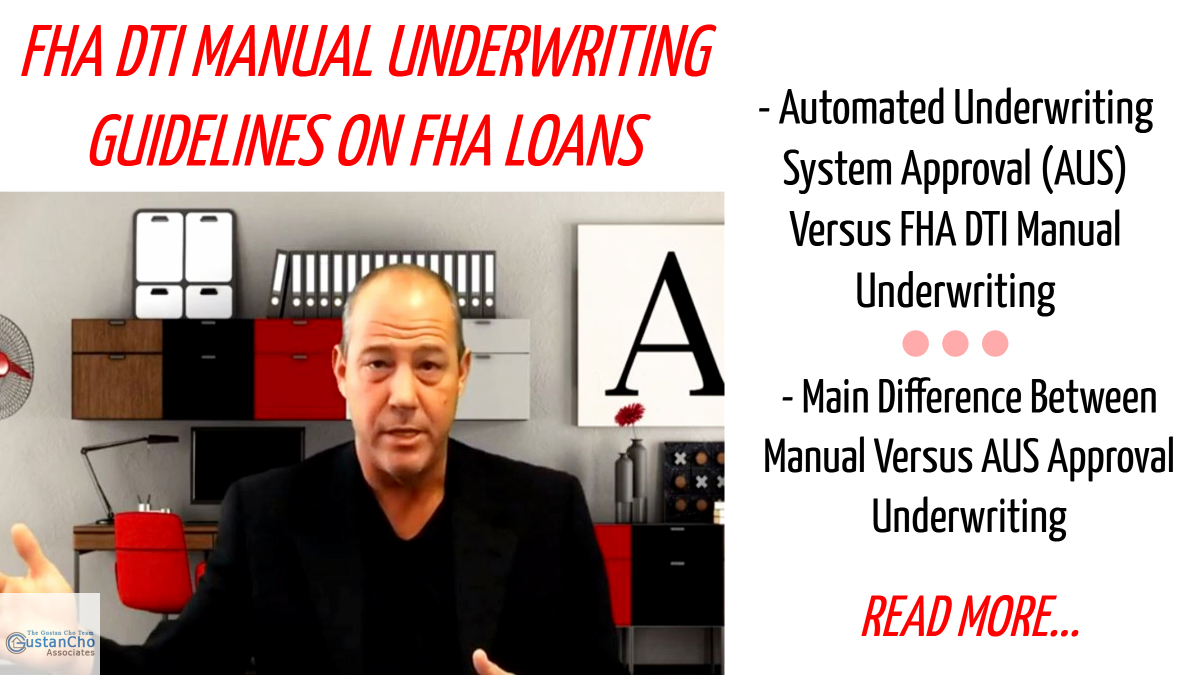FHA DTI Manual Underwriting Guidelines On FHA Loans
This Article Is About FHA DTI Manual Underwriting Guidelines On FHA And VA Loans
FHA Manual Underwriting is going to become more and more common on FHA Loans. HUD, the parent of FHA, recently changed its algorithms for FHA AUS Approval for borrowers under 640 FICO.
- It is now tougher to get an FHA AUS Approval for borrowers with under 640 FICO
- More borrowers with credit scores under 640 FICO will get a refer/eligible per automated underwriting system (AUS) than before due to FHA algorithm changes recently
- What this means is that more and more borrowers will need manual underwriting on their FHA Loans
- The main difference between manual versus automated underwriting is FHA DTI Manual Underwriting has lower debt to income ratio restrictions
In this blog, we will discuss FHA DTI Manual Underwriting Guidelines versus automated underwriting system DTI requirements.
Automated Underwriting System Approval (AUS) Versus FHA DTI Manual Underwriting

All government and conforming loans need to go through either Fannie Mae or Freddie Mac’s Automated Underwriting System (AUS).
- Fannie Mae’s Automated Underwriting System is called Desktop Underwriter or DU
- Freddie Mac’s Automated Underwriting System (AUS) is the Loan Prospector or LP
- The automated underwriting system (AUS) is an intricate sophisticated computerized automated mortgage system that analyzes borrowers credit and income profile
- The AUS will analyze the data inputted by the loan officer such as the credit report, 1003 mortgage application, asset, liabilities, public records, property information, and all other pertinent data and render an automated decision in a matter of seconds
Approve/Eligible Versus Refer/Eligible AUS Findings And FHA DTI Manual Underwriting
The three findings rendered by the AUS are the following:
- Approve/Eligible: This automated findings means the borrower has an automated underwriting system approval
- Refer/Eligible: This means that the automated findings cannot render an automated approval and needs a human mortgage underwriter to analyze and review the mortgage file via manual underwriting
- Refer With Caution: This means the AUS has denied the loan application due to the borrower not meeting the loan programs mortgage guidelines
What Are Compensating Factors

Compensating Factors are important for borrowers whose files are manually underwritten with higher debt to income ratios. Here is what compensating factors are when it comes to FHA and VA Manual Underwrites:
HUD, the parent of FHA, allows gift funds for the down payment and closing costs.
Gift funds are not viewed favorably. Gift funds show weakness. This is because the home buyer is relying on the down payment from a family member or relative. The borrower does not have their own skin in the game. Own sourced funds for the down payment and closing costs versus gift funds are considered a compensating factor. Employment history – A long employment history shows job stability and the likelihood for future employment. Longevity on the current job carries a lot of weight versus multiple jobs and gaps in employment in the past two years. Lenders view consistent pay increases as a strong sign of future job stability. If borrowers had a history of job promotions, this too is viewed very favorably. Borrowers with a history of going to school throughout the year to better himself and/or herself, this is considered another positive sign of future job stability. Borrowers with income that cannot be used but can be verified because of not having a two-year history and/or proof that the income will continue for the next three years, this will be considered good likelihood of financial security. For example, borrowers with a part-time job or overtime income for the past 18 months, but the income cannot be used because the minimum required for a part-time job and/or overtime income is at least a 24-month history. This is verifiable income but cannot be used for income qualification
Main Difference Between Manual Versus AUS Approval Underwriting
The only major difference between manual versus automated underwriting is capping on debt to income ratio.
- The maximum debt to income ratio allowed on automated underwriting system approvals on FHA Loans is 46.9% front end and 56.9% back end
- However, FHA DTI Manual Underwriting has a lower debt to income ratio caps
- Debt to income ratio limits is determined by compensating factors on FHA Loans
Here are the FHA DTI Manual Underwriting Mortgage Guidelines:
Borrowers with credit scores under 580 FICO or borrowers who need to be underwritten with non-traditional credit. The maximum debt to income ratio required is 31% front end and 43% DTI back end. Borrowers with at least a 580+ credit score with NO compensating factors, the maximum front end debt to income ratio is 31% DTI and 43% DTI back end. Borrowers with at least a 580 credit score and ONE compensating factor, the maximum front end debt to income ratio is 37% DTI and maximum back end debt to income ratio is 47% DTI. Borrowers with at least a 580+ credit score with TWO compensating factors, the maximum front debt to income ratio is 40% DTI and maximum back end DTI is 50% DTI. Borrowers with at least a 580+ FICO credit score with NO discretionary debt, the maximum front end debt to income ratio is capped at 40% DTI and maximum back end is capped at 40% DTI. Read more Read more https://www.mortgagelendersforbadcredit.com/fha-manual-underwriting/







